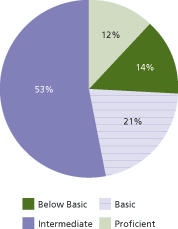
|
Office of
Disease Prevention and Health Promotion Health Communication Activities |
Health literacy—the ability to obtain, process, and understand basic health information and services to make appropriate health decisions—is essential to promote healthy people and communities. Health care institutions and public health systems play a critical role in health literacy, because they can make it easier or more difficult for people to find and use health information and services. For the first time, there are national data that demonstrate currently available health information is too difficult for average Americans to use to make health decisions.
Limited health literacy isn't a disease that makes itself easily visible. In fact, you can't tell by looking. Health literacy depends on the context. Even people with strong literacy skills can face health literacy challenges, such as when:
This brief summarizes key findings and presents some policy implications of the first ever National Assessment of Adult Literacy (NAAL). These findings include:
Table 1. Descriptions of Health Literacy
| Health Literacy Level | Task Examples | Percentage |
|---|---|---|
| Proficient | Using a table, calculate an employee's share of health insurance costs for a year. | 12% |
| Intermediate | Read instructions on a prescription label, and determine what time a person can take the medication. | 53% |
| Basic | Read a pamphlet, and give two reasons a person with no symptoms should be tested for a disease. | 21% |
| Below Basic | Read a set of short instructions, and identify what is permissible to drink before a medical test. | 14% |
The 2003 NAAL produced the first national assessment of health literacy.
77 Million Adults Have Basic or Below Basic Health Literacy
As shown in Figure 1, only 12 percent of U.S. adults had proficient health literacy. More than a third of adults were in the basic (47 million) and below basic (30 million) health literacy groups. The majority of adults (53 percent) had intermediate health literacy skills.
Figure 1. Adults' Health Literacy Level: 2003

Source: U.S. Department of Education, Institute of Education Sciences, 2003 National Assessment of Adult Literacy.
|
Below Basic |
Basic |
Intermediate |
Proficient |
|---|---|---|---|
|
14% |
21% |
53% |
12% |
Figure 2 shows that all racial/ethnic groups contained adults who were at the below basic or basic levels of health literacy, although the rates varied. Whites have the lowest share (28 percent) of adults at these levels, followed by the "Other" category (which includes Asians, Native American, and multi-racial adults), blacks, and Hispanics, who have the largest share (65 percent) of adults at these levels.
Figure 2. Adults' Health Literacy by Racial/Ethnic Groups: 2003
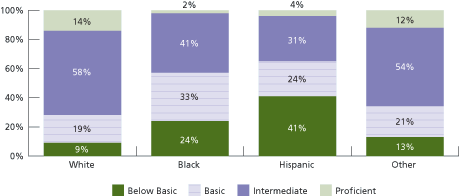
Source: U.S. Department of Education, Institute of
Education Sciences, 2003 National Assessment of Adult Literacy.
Note:
Racial/ethnic categories are mutually exclusive; white, black, and other adults
are not Hispanic.
|
Ethnic Group |
Below Basic |
Basic |
Intermediate |
Proficient |
|---|---|---|---|---|
|
White |
9% |
19% |
58% |
14% |
|
Black |
24% |
33% |
41% |
2% |
|
Hispanic |
41% |
24% |
31% |
4% |
|
Other |
13% |
21% |
54% |
12% |
Figure 3 shows the racial/ethnic breakdown of adults that fell in the below basic health literacy group. White adults constituted the largest percent of the below basic group (41 percent), followed by Hispanic adults (35 percent).
Figure 3. Percentage of Adults at Below Basic Health Literacy, By Race/Ethnicity: 2003
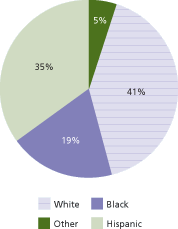
Source: U.S. Department of Education, Institute of
Education Sciences, 2003 National Assessment of Adult Literacy.
Note:
Racial/ethnic categories are mutually exclusive; white, black, and other adults
are not Hispanic.
|
White |
Black |
Hispanic |
Other |
|---|---|---|---|
|
41% |
19% |
35% |
5% |
Health literacy varies directly with level of education (see Figure 4). Over three-quarters of adults with less than a high school degree were at the below basic level or basic level; that percentage decreased dramatically as education level increased. While health literacy increased with higher educational attainment, 44 percent of high school graduates and 12 percent of college graduates had below basic or basic health literacy.
Figure 4. Adults' Health Literacy, By Highest Level of Educational Attainment: 2003
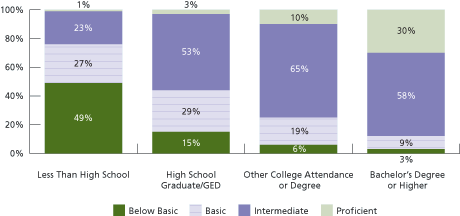
Source: U.S. Department of Education, Institute of Education Sciences, 2003 National Assessment of Adult Literacy.
|
Education |
Below Basic |
Basic |
Intermediate |
Proficient |
|---|---|---|---|---|
|
Less than High School |
49% |
27% |
23% |
1% |
|
High School Graduate/GED |
15% |
29% |
53% |
3% |
|
Other College Attendance or Degree |
6% |
19% |
65% |
10% |
|
Bachelor's Degree or Higher |
3% |
9% |
58% |
30% |
Adults 65 or older were more likely to have below basic or basic health literacy skills than those under 65. The share of adults at these lower levels of literacy was greatest for those over 75; more than two-thirds had below basic or basic health literacy. Age had relatively little relationship to health literacy among adults who were under 65 years of age.
Figure 5. Health Literacy of Adults, By Age: 2003
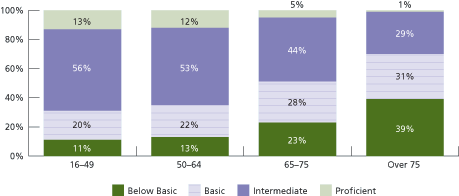
Source: U.S. Department of Education, Institute of Education Sciences, 2003 National Assessment of Adult Literacy.
|
Age |
Below Basic |
Basic |
Intermediate |
Proficient |
|---|---|---|---|---|
|
16–49 |
11% |
20% |
56% |
13% |
|
50–64 |
13% |
22% |
53% |
12% |
|
65–75 |
23% |
28% |
44% |
5% |
|
Over 75 |
39% |
31% |
29% |
1% |
Figure 6 shows that uninsured adults and those enrolled in Medicare and Medicaid were more likely to be at the below basic or basic level of health literacy than those adults who received insurance from an employer. Whereas about one-fourth of those with employment-based health insurance were in the below basic or basic health literacy group, well over half of uninsured persons, Medicare beneficiaries, and Medicaid beneficiaries were in these groups.
Figure 6. Adults' Health Literacy, By Type of Health Insurance: 2003
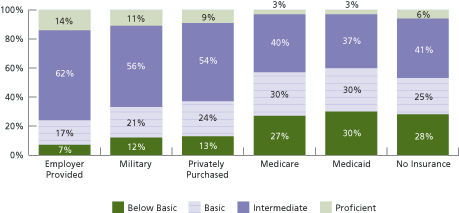
Source: U.S. Department of Education, Institute of Education Sciences, 2003 National Assessment of Adult Literacy.
|
Insurance Source |
Below Basic |
Basic |
Intermediate |
Proficient |
|---|---|---|---|---|
|
Employer Provided |
7% |
17% |
62% |
14% |
|
Military |
12% |
21% |
56% |
11% |
|
Privately Purchased |
13% |
24% |
54% |
9% |
|
Medicare |
27% |
30% |
40% |
3% |
|
Medicaid |
30% |
30% |
37% |
3% |
|
No Insurance |
28% |
25% |
41% |
6% |
Adults at all levels of health literacy used multiple sources to obtain health information; no one source clearly predominated. Adults with the most limited health literacy rarely use digital resources for health information.
There is an urgent need to address the gap between the health information currently available and the skills people have to understand and use this information to make life-altering decisions. The following strategies are options for policymakers, health care administrators, educators, and health care and public health professionals to consider.
The success of health system reform will depend in large part on the capacity of individuals, families and communities to make informed decisions about their health. Health literacy is lowest among the more vulnerable members of our communities—those with lower education levels, racial/ethnic minorities, the uninsured and publicly insured, and the elderly. Innovative approaches, as well as application of existing best practices to developing and disseminating health information, are necessary if we are going to increase the likelihood that people will make healthy choices, successfully manage their own health, and make the best use of limited health care resources. The most promising options should be pursued simultaneously:
Policymakers, health care administrators, educators, and health care and public health professionals can take advantage of the many options at their disposal to create a society that is sensitive to the health literacy needs of its population and provides accessible health information that matches the health literacy skills of the American public.
The 2003 National Assessment of Adult Literacy (NAAL) is a nationally representative assessment of English literacy among American adults age 16 and older. Over 19,000 adults from 38 states and the District of Columbia participated in the national and State-level assessments to create data for the NAAL.
The health literacy component of the NAAL measured how well Americans performed tasks with printed health information. Adults were asked to perform tasks with material that was chosen to be representative of real-world, health-related material, including insurance information, directions for taking medicine, and preventive care information.
The NAAL results are grouped into four levels of health literacy-below basic, basic, intermediate, and proficient. See Table 1 for examples of tasks at each level of health literacy. The number of adults at each health literacy level was generated based on the size of the adult population when the NAAL was fielded.
The NAAL also included a background questionnaire in which respondents provided information on their age, race/ethnicity, gender, language, education, income and employment, health status, insurance coverage, and the sources respondents used to obtain information on health topics, along with the importance of these sources. Standard t-tests were used to determine statistical significance of differences among group. All reported differences were significant at the p < .05 level.
More detailed information on the NAAL health literacy methodology and
results can be found in Assessing the Nation's Health Literacy: Key
Concepts and Findings of the National Assessment of Adult Literacy,
available at
http://www.ama-assn.org/ama1/pub/upload/mm/367/hl_report_2008.pdf
[PDF File - 2.03 MB].
![]()
American Medical Association. Health literacy kit. Chicago, IL. 2007.
https://catalog.ama-assn.org/Catalog/product/product_detail.jsp?productId=prod1060004.
![]()
American Alliance for Health, Physical Education, Recreation, and Dance.
National health education standards: achieving excellence. Reston, VA. 2007.
http://www.aahperd.org/aahe/pdf_files/standards.pdf
[PDF File - 51 KB].
![]()
American College of Physicians Foundation. Philadelphia, PA.
http://www.foundation.acponline.org/index.htm.
![]()
Berkman ND, DeWalt DA, Pignone MP, et al. Literacy and health outcomes. Rockville, MD: Agency for Healthcare Research and Quality. 2004. http://www.ahrq.gov/clinic/tp/littp.htm.
Harvard School of Public Health, Health Literacy Studies. Boston, MA.
2007. http://www.hsph.harvard.edu/healthliteracy/.
![]()
Institute of Medicine. Health literacy: a prescription to end confusion. Washington, DC: The National Academies Press. 2004.
U.S. Department of Health and Human Services, Office of Disease Prevention and Health Promotion. Health literacy improvement. Rockville, MD. http://www.health.gov/communication/literacy/default.htm.
The Office of Disease Prevention and Health Promotion works to strengthen the disease prevention and health promotion activities of the U.S. Department of Health and Human Services (HHS) within the collaborative framework of the HHS agencies.
Suggested Citation: America's Health Literacy: Why We Need Accessible Health Information. An Issue Brief From the U.S. Department of Health and Human Services. 2008.
Note: Documents in PDF format require the Adobe Acrobat Reader®. If you experience problems with PDF documents, please download the latest version of the Reader®.